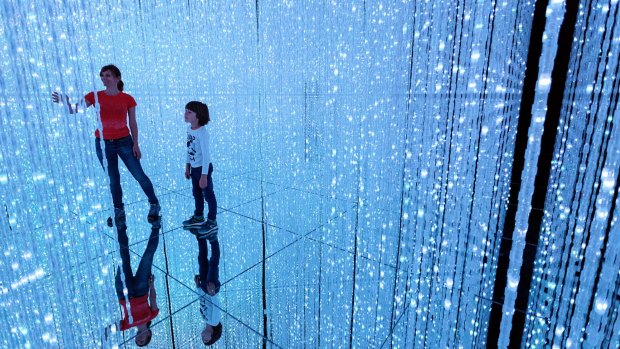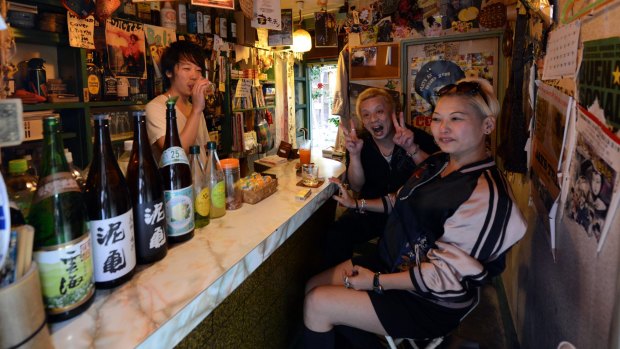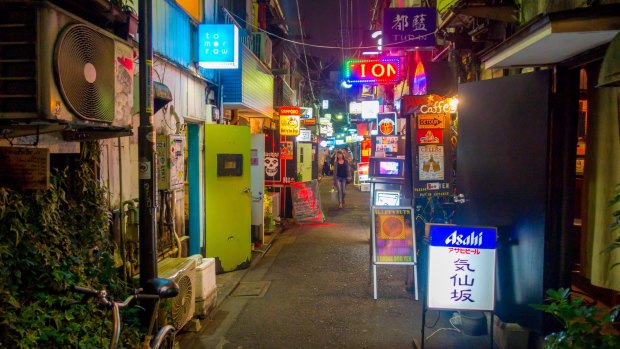This was published 5 years ago
Japan: The art of touring Tokyo in the wake of Joni Waka
By Luke Slattery

The Mori Building Digital Art Museum is the world's first digital art museum. Credit: Alamy
A bald man with a mischievous grin meets me at Haneda airport and beats a path to his car where, he explains, a "hairy friend" is waiting. The man's name is Joni Waka – pronounced after the ubiquitous whisky – and his hirsute friend turns out to be a Rhodesian Ridgeback named Bogie who lands lightly on all fours, despite his 50-kilogram frame, when Waka opens the boot.
Waka is an identity in the Tokyo art world: an impresario, a fixer for Western galleries seeking out Japanese talent, and the director of an art foundation. He also runs art and design tours of the miracle city, its machine-like angularity softened by the light of a November dawn as we drive the short distance from Haneda to the city centre. Bogie is a Tokyo identity in his own right, but it's Waka who does the talking as my art tour begins.
"The first thing you need to know is that in Japan, about 60 years after it was opened to the West, most lay people had begun to think their traditional arts and crafts were rubbish," he explains as we sweep along a near-empty motorway. "Everything from the West was good."

A colourful tiny bar in the Golden Gai area in Shinjuku.Credit: Alamy
"In the 1920s and '30s, as a response to modernisation and westernisation, you had the Mingei folk art movement that helped to revive Japanese arts and crafts as a medium in contemporary modern design and art. That spirit is very much alive today in Japan."
Waka can slice and dice the Japanese art scene any which way but this, he tells me, is his chosen theme for my tour: "We'll be seeing a lot of tradition made new – of reinvention."
The time difference between Sydney and Tokyo may be minimal but the cultural gulf is vast and I take the morning to get my bearings. As the autumn afternoon closes in I meet up with Waka at the '70s-era Sogetsu Kaikan building opposite the Akasaka Imperial gardens: a dense wall of bronze foliage smouldering in the fading light.

Traditional back street bars in Golden Gai.Credit: Shutterstock
The main lobby is a tiered stone garden and waterfall designed by Japanese-American Isamu Noguchi. It goes by the lofty title "heaven". Noguchi's most recognisable works are his light sculptures handmade with washi paper, variations of which are as common in student households as cheap wine. But Noguchi, who studied with Brancusi in Paris, also had a thing about stone. His somewhat quarry-like garden isn't for everyone, but the artist's ideal of environmental art within an urban frame was certainly prescient.
Afterwards, we drop in on a local abstract photographer, Yasuo Konishi, and his American wife Kate Klippenstein, a writer. The couple live in an urban version of a dacha: an inner city household with a country air. Konishi's most recent work – variations on the theme of light, water and reflection – is a teaching. Like all great photography, it shows you how to see.
After downing a can of Yebisu – the locals' preferred lager – we head to dinner at Higashi-Yama in the hip Nakameguro district, so named because it straddles the Meguro River canal. The canal, lined with sakura trees, is embowered with cherry blossom each spring but on this, the first cool night of the new season, the trees have begun their journey towards wintry abstraction.
Even by Japan's lofty standards of interior design, Higashi-yama, the creation of design company Simplicity, is special.
We step inside and Waka introduces me to a tall, distinguished Japanese man polishing glasses in a sunken bar topped with textured wood. "The best barman in Tokyo," my host offers as we wind our way through the darkened interior, up a flight of brass steps, into a dining room with cream-coloured walls commanded by a long shared table and smaller intimate settings on either side. Raised slightly above, like an observation deck, is a bustling open kitchen aglow with brass surfaces, copper pans and kitchen knives that flash like rapiers. A sous chef with the concentration of a Zen master plates a dish.
Everything in this space – including the menu – is the work of Shinichiro Ogata, a Japanese designer with a renaissance array of talents: he designed the gourd-inspired soy sauce bottles on the tables, the beaten pewter sake containers, the lacquer wear, the brass stairwell, the long plunging picture window. He's an exponent, Waka tells me, of "total design".
There is nothing particularly fancy about the place, and yet nothing is uninspired. Every object is a thing of beauty. Even the toilet rolls stacked above the loo inhabit their own individual curatorial niches.
"I talked about the Japanese revival of the old in terms of the new," says Waka, as the waiter tops up the sake container from a nebuchadnezzar-sized bottle and the tempura arrives on a charcoal-coloured rectangular plate. "That's what Ogata sets out to achieve. Traditional craft revived through contemporary design."
The next day, with Bogie along for the ride, we drop in at the temple of Jokan-ji in the humble district of Arakawa.
"Close by, from the end of the 17th century, was the licensed red light district of Yoshiwara," explains Waka. As Yoshiwara was accessible only by water, it became known as the "floating world". The phrase was taken up by Japan's most famous pre-industrial art form: the ukiyo-e (literally "pictures of the floating world"). The movement produced woodblock prints of courtesans, actors and pleasure seeking crowds.
But such was the lowly status of the prostitutes of Yoshiwara that in death they were rarely dignified with a temple burial. "Sometimes their corpses were simply thrown in the river," Joni says. Jokan-ji became known as the "dumping temple". One theory is that the bodies of prostitutes were dumped outside its walls.
The head priest of Jokan-ji eventually decided to bury the "unclean" on sacred ground. Thereupon the local dignitaries took their dead to another temple. In one corner of Jokan-ji cemetery stands a deity dedicated to the world's most venerable profession. Carved in high relief, with slim eyes, she has a Buddha's elongated earlobes and wears a curious bright scarlet bib. Fresh flowers are strewn at her feet and above her, on a lintel, spreads a collection of fading costume jewellery, makeup, fans, baubles – accoutrements of the courtesan. It's an installation of the most profound sort: people's art.
Next stop is the old-world district of Yanaka. There is something a little Kyoto-like about this suburb of undulating hills and traditional wooden stores selling rice cakes flavoured with nori (a favourite of Bogie's), pickled piscine concoctions in ceramic bowls, sweet buns, tea and ceramics.
Waka leads me to an art shop with local prices. I walk out with two original haikus – not prints but paintings. One was composed in 1887 and the dashing calligraphy, on slightly mottled paper, dates from the 1970s. "Give yourself to nature like flowing water," it reads. Nice. "Cranes and turtles live long," reads my other purchase. Interesting.
SCAI, the bathhouse a few metres down the road, was a traditional mixed-sex onsen until the coming of the Americans, with their libertine-puritan complications. From that point the genders were separated. Still visible are the numbered lockers.
The main attraction here is a small yet ambitious exhibition space and today its centrepiece is an organic sculpture by Japanese artist Kohei Nawa titled Biomatrix: a bed of gentle geysers, arranged in a grid, with an oleaginous sheen and a brassy tone. The effect is at once seductive and creepy.
In my short time with Waka I've struggled to get a fix on his place in Japanese society. Though he speaks Japanese, and owns a Japanese passport, his family hails from Harbin in northeastern China. Now and then he refers to an Indian childhood. He is, in fact, an orientalised Sephardic Jew. "During the war a decision was made to allow a small number of Jewish families into the country to stimulate business," he explains.
The next day we tour galleries and design spaces as far afield as the Mori museum, gallery and nearby exhibition spaces in Rappongi Hills, and the national museum in Ueno. There, on the second floor, a dimly lit exhibition is showing examples of ukiyo-e and Edo fashion that recall Yoshiwara in its prime.
That night we wash up at the 52nd floor of the Park Hyatt: Lost in Translation territory.
Before entering the lobby a posse of staff appears for Bogie. He trots off with this excited entourage to what Waka describes as "his room". Waka and Bogie are habitues of the Park Hyatt – while Waka dines, Bogie chills – and I picture this very singular pooch on an ottoman, luxuriating in his own bathrobe, with Animal Planet on cable and a bowl of nori flavoured rice crackers at his side.
Tokyo is a largely mid-rise city and from this height it swirls below us like a diamantine sea. In fact, something about the Park Hyatt vibe – the jazz-rock band, the California-heavy wine list, the smart casual dress code, the Western menu – puts me in mind of an upmarket cruise ship.
Retrieving Bogie from his suite we head to gritty Shinjuku. A raucous festival and night market is underway at the Hanazono Shinto shrine: packed, and jumping, at midnight.
It's a short walk from the temple to Golden Gai: a network of neon-lit lanes and pocket-sized bars. The place is its own little floating world: a living breathing ukiyo-e.
Waka's favourite bar is a shoebox-sized joint called La Jetee, reached by a steep flight of stairs. It's run by a Japanese Francophile and fits three drinkers at the bar and a gathering of five – including Waka, Bogie and me – at a table in the corner.
La Jetee might not seem at first sight to have much bearing on the Tokyo art scene, but it turns out to be a worthy inclusion and fitting farewell. The bar, named for a film by French director Chris Marker, is plastered with faded film posters, and is said to be Wim Wenders' favourite Tokyo haunt. In his documentary-homage to the city, titled Tokyo-ga, Wenders meets Marker at La Jetee.
We befriend a New Yorker who works for several global film festivals and talk into the night about Wenders and Kurosawa and Sakamoto and where cinema was, is, and might be heading. Tea cup-sized servings of sake come and go. Someone raises the subject of Netflix the dominatrix but we decide the room's not big enough for that particularl elephant, especially with Bogie beneath the table.
I leave La Jetee well after midnight, with Waka and Bogie leading the way through Shinjuku's neon chiaroscuro, adrift in a floating world.
TRIP NOTES
Luke Slattery travelled to Japan as a guest of the National Gallery of Victoria (NGV) to preview its Escher X nendo: Between Two World exhibition running until April 7. See ngv.vic.gov.au
MORE
FLY
Qantas has daily nonstop flights to Haneda airport, Tokyo. See qantas.com
TOUR
Check out the view of Tokyo from the 52nd floor of the Mori Tower, Rappongi Hills, and visit the Mori Art Museum above it on the 53rd floor. Contact Joni Waka for specialist art and culture tours, email art@theartfoundation.com or see theartfoundation.com
STAY
The Royal Tokyo Park Hotel is 20 minutes by train to Haneda. Double rooms start at about $400 a night. See en.parkhoteltokyo.com
Sign up for the Traveller Deals newsletter
Get exclusive travel deals delivered straight to your inbox. Sign up now.